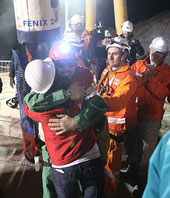How to Lead During a Crisis: Lessons From the Rescue of the Chilean Miners
When 33 Chilean miners were rescued after being trapped underground for 69 days, the world cheered. Here’s what your company can learn from key leadership decisions made during the mine cave-in crisis.

Mario Sepulveda, 39, was the second miner to leave the San Jose mine with the Phoenix rescue capsule the night of October 13, 2010.
Image courtesy of Flickr user Rescate Mineros.
The smart phone of Chile’s minister of mining, Laurence Golborne, came to life at 11 p.m. on Aug. 5, 2010, with a text message made even more chilling by its brevity and lack of detail: “Mine cave-in Copiapó; 33 victims.” Sixty-nine days later, standing by the mine, Golborne — along with an estimated 1 billion television viewers — watched as the cave-in victims emerged unscathed. A rescue crew had worked literally around the clock for more than two months to retrieve the 33 miners below, but direct responsibility for their recovery ultimately resided in just one individual — Golborne. The decisions he and his hand-picked team made during the length of the crisis contain instructive implications for all who face catastrophic risks or disasters.
Leadership Decisions in Crisis
Those who study catastrophic events — whether earthquakes, financial storms or mine collapses — often divide attention among three phases of the calamity, each calling for distinct forms of preparation or response: (1) the conditions leading up to a catastrophic event, (2) the immediate crisis brought on by the disaster, and (3) the recovery from it. For example, in the case of the BP oil spill in the Gulf of Mexico caused by an oil rig explosion in April 2010, attention was separately directed at the conditions that led to the blowout, the decisions of those responsible in the immediate aftermath of the explosion and the steps the company later followed to prevent recurrence.1
The Leading Question
What is the most effective way for a leader to handle an unprecedented crisis?
Findings
- Take charge if you are best positioned to make the difference.
- Assemble the essential experts on your top team, but keep the number small.
- Delegate decisions beyond your expertise, but retain oversight of them.
Research indicates that the influence of organizational leadership is greatest when an enterprise is facing uncertain and changing circumstances, and those conditions are arguably most acutely felt during the immediate crisis in the wake of a disaster.
References
1. H. Kunreuther and M. Useem, “Learning from Catastrophes” (Upper Saddle River, New Jersey: Prentice Hall, 2010); BP, “Deepwater Horizon Accident Investigation Report,” Sept. 8, 2010; and National Commission on the BP Deepwater Horizon Oil Spill and Offshore Drilling, “Deep Water: The Gulf Oil Disaster and the Future of Offshore Drilling” (Washington, D.C.: GPO, 2010).
2. D.A. Waldman, G.G. Ramírez, R.J. House and P. Puranan, “Does Leadership Matter?: CEO Leadership Attributes and Profitability Under Conditions of Perceived Environmental Uncertainty,” Academy of Management Journal 44, no. 1 (February 2001): 134-143.
3. G. Yukl, “Managerial Leadership: A Review of Theory and Research,” Journal of Management 15, no. 2 (1989): 251-289.
4. C.I. Barnard, “The Functions of the Executive” (1938; repr., Cambridge: Harvard University Press, 1968), 193.
5. R. Jordan and M. Garay, “Liderazgo real: De los fundamentos a la práctica” [Real Leadership: From Theory to Practice] (Santiago, Chile: Pearson Prentice Hall, 2009); and M. Useem, J. Cook and L. Sutton, “Developing Leaders for Decision Making Under Stress: Wildland Firefighters in the South Canyon Fire and Its Aftermath,” Academy of Management Learning and Education 4, no. 4 (December 2005): 461-485.
6. J. Franklin, “33 Men: Inside the Miraculous Survival and Dramatic Rescue of the Chilean Miners” (New York: Putnam, 2011); and M. Pino Toro, “Buried Alive: The True Story of the Chilean Mining Disaster and the Extraordinary Rescue at Camp Hope” (New York: Palgrave Macmillan, 2011).
7. L.A. Hill and K.L. Lineback, “Being the Boss: The 3 Imperatives for Becoming a Great Leader” (Boston: Harvard Business Press, 2011).
8. J. Collins, “Good to Great: Why Some Companies Make the Leap ... and Others Don’t” (New York: HarperBusiness, 2001).
9. T.J. Neff and J. M. Citrin, “You’re in Charge — Now What?: The 8 Point Plan” (New York: Crown Business, 2007).
10. K.M. Eisenhardt, “Speed and Strategic Choice: How Managers Accelerate Decision Making,” California Management Review 32, no. 3 (1990): 39-54.
11. A. Gawande, “The Checklist Manifesto: How to Get Things Right” (New York: Metropolitan Books, 2009).

Comment (1)
Inside the Crisis: How One Small Team Managed the Search for Flight 370 - Small Business Today